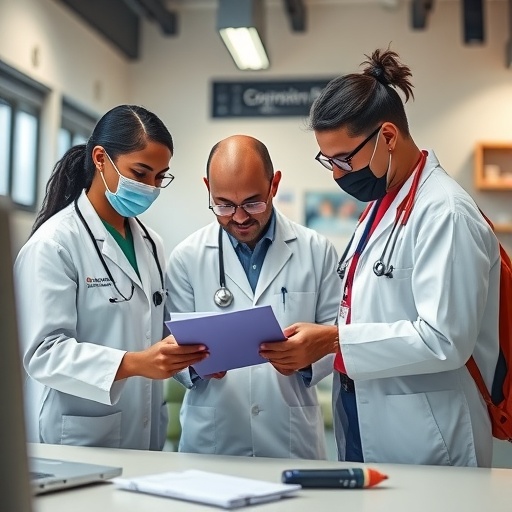
Credit: UC San Diego Health
Researchers from University of California San Diego School of Medicine, with statewide collaborators, report that patients who recorded videos of themselves taking tuberculosis (TB) medications better adhered to treatment than patients who were observed in-person.
The study also found that using a smartphone, called video directly observed therapy (VDOT), cost less and was preferred over in-person directly observed therapy (DOT). Study results appear in the October print edition of Emerging Infectious Diseases.
"Prior studies showed that VDOT worked well in urban areas with large TB control programs. This time we wanted to know if VDOT would be as effective in monitoring TB in rural counties with smaller health departments," said first author Richard Garfein, PhD, MPH, professor in the Division of Epidemiology, part of UC San Diego School of Medicine.
The study took place in California, which reports the highest number of TB cases in the United States. Garfein and his team found that VDOT results were similar across five diverse counties. He said this is promising news for health departments in the U.S. that manage too few TB cases annually to justify designating staff exclusively to TB response. San Diego was the first county in the U.S. to employ VDOT using recorded videos.
"Outside of the U.S., VDOT offers a new method of managing large numbers of patients with TB where the disease is rampant and resources are limited," said Garfein.
TB is the world's leading cause of death from an infectious disease. The condition is treatable, but therapy typically takes six months. Patients must take approximately 12 antibiotic pills per day to cure the disease, avoid transmission and prevent antibiotic resistance. Drug-resistant TB can require up to two years to treat.
Since medication side effects can make patients feel sick, even after their TB symptoms subside, the Centers for Disease Control and Prevention (CDC) and the World Health Organization (WHO) recommend watching patients swallow every dose of medication using DOT to ensure they complete their treatment. VDOT is a new way for health workers to monitor medication adherence and support patients who struggle with treatment.
With VDOT, patients used a smartphone and a HIPAA compliant application to record the administration of each medication dose and send videos to their medical provider. Study participants who used VDOT had 93 percent of their medication doses observed on schedule compared with 66 percent among patients who used DOT. The study involved 274 participants who used VDOT for a median period of 5.4 months. Overall, patients' ages ranged from 18 to 87 years. Sixty-one percent were male; 72 percent owned a smartphone.
"Most patients report that it is less burdensome to make a video in private at a convenient time rather than allowing a health worker come to their home, workplace or school every day. VDOT also allows health workers to observe doses taken at night, on weekends and holidays. This saves the health department in travel costs and shortens treatment duration by not having to make up missed doses," said Garfein.
"Studies like this add to the growing body of evidence required by the CDC, WHO and other health agencies around the world to adopt VDOT as a new tool in the fight to eliminate TB."
###
Co-authors include: Lin Liu, Jazmine Cuevas-Mota, Kelly Collins, Fatima Muñoz, Javier Cepeda, Michelle Bulterys, Natasha Martin, Philip Rios, Fredric Raab, all at UC San Diego; Donald Catanzaro, University of Arkansas; Kathleen Moser, San Diego County Health and Human Services Agency; Julie Higashi, San Francisco Department of Public Health; Teeb Al-Samarrai, Santa Clara County Public Health Department; Paula Kriner, Imperial County Public Health Department; and Julie Vaishampayan, San Joaquin Public Health Services.
Disclosure: Garfein is a cofounder of SureAdhere Mobile Technology, Inc., a VDOT service provider. No funding, software or other resources were provided by SureAdhere for the study. All interpretation and reporting of study findings were approved by coauthors unaffiliated with SureAdhere.
Media Contact
Jackie Carr
[email protected]
858-249-0456
@UCSanDiego
http://www.ucsd.edu
Related Journal Article
http://dx.doi.org/10.3201/eid2410.180459





